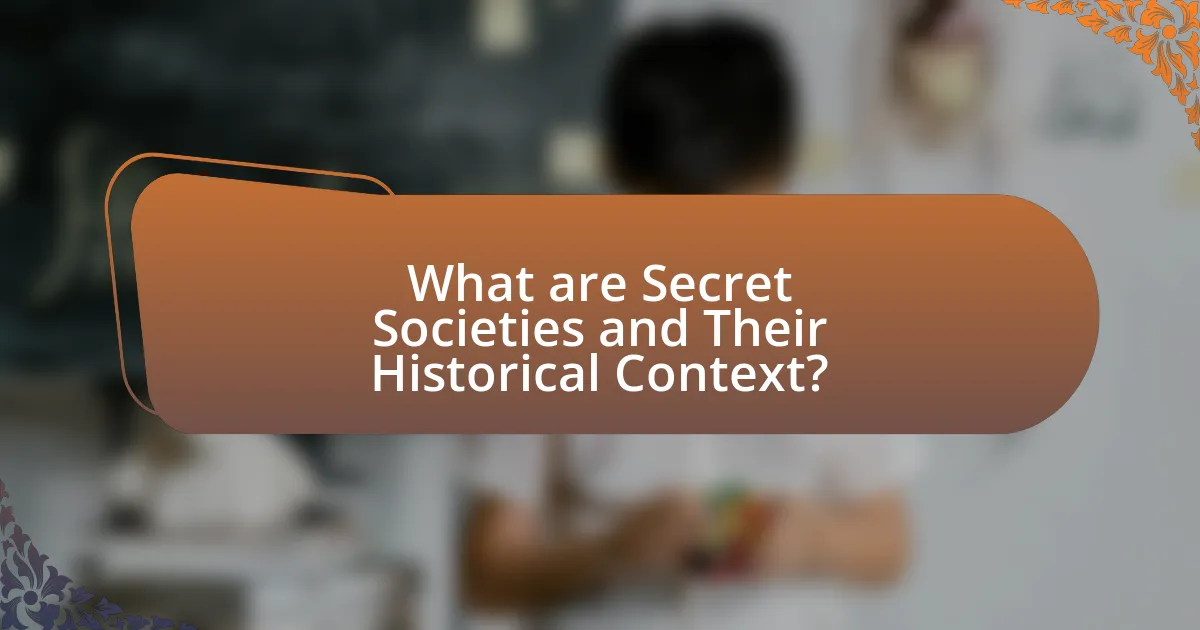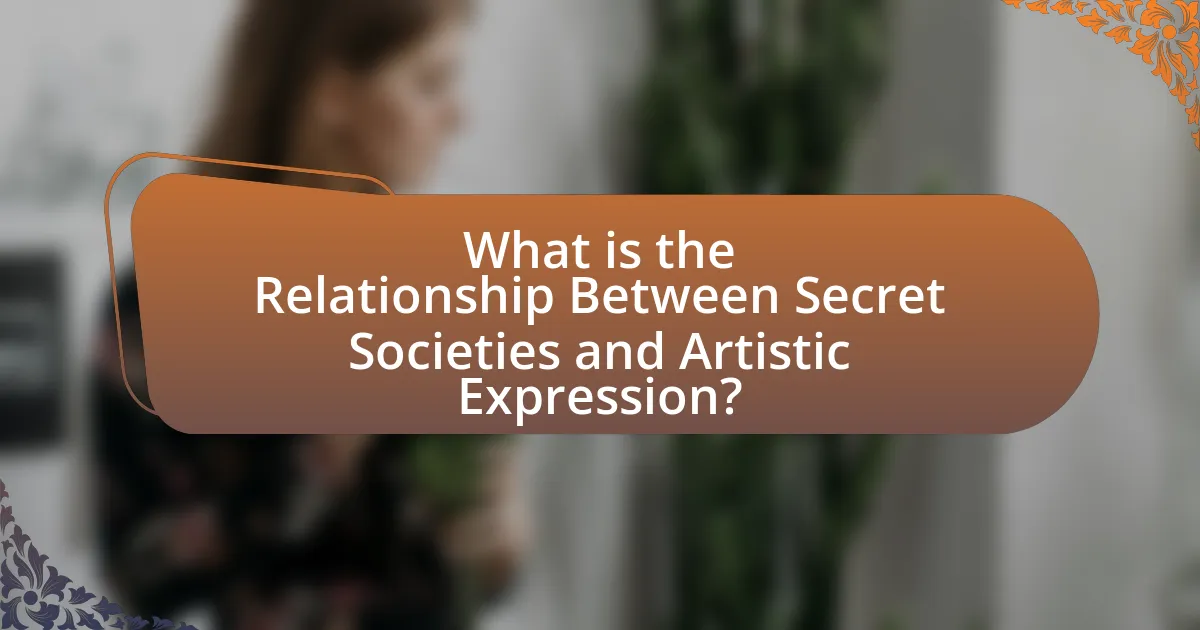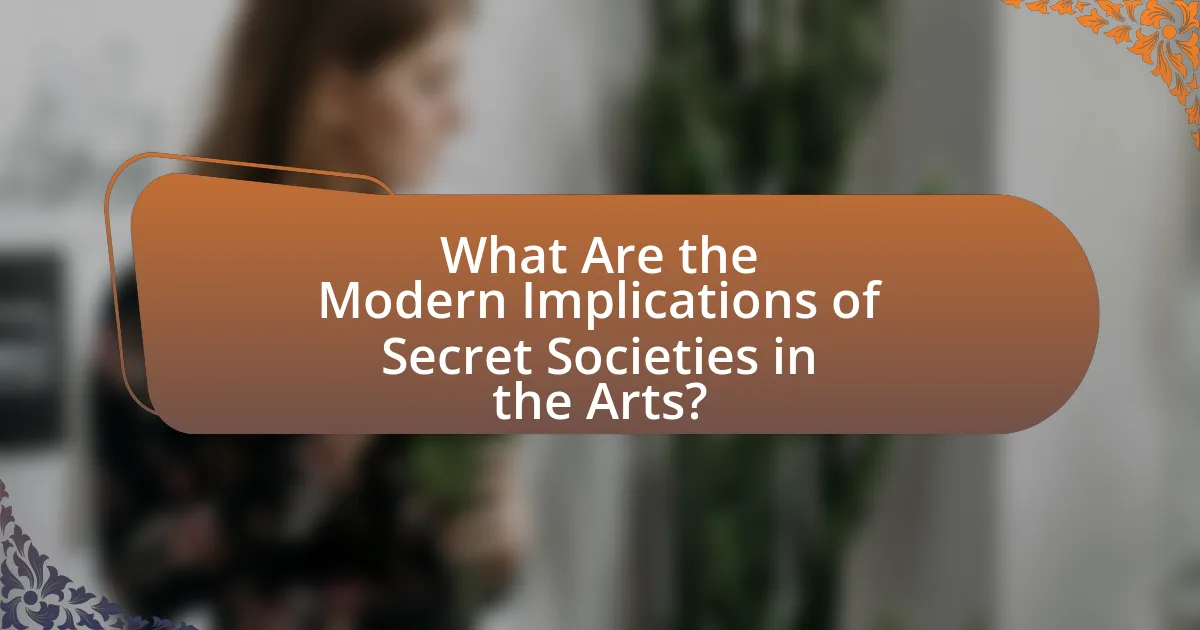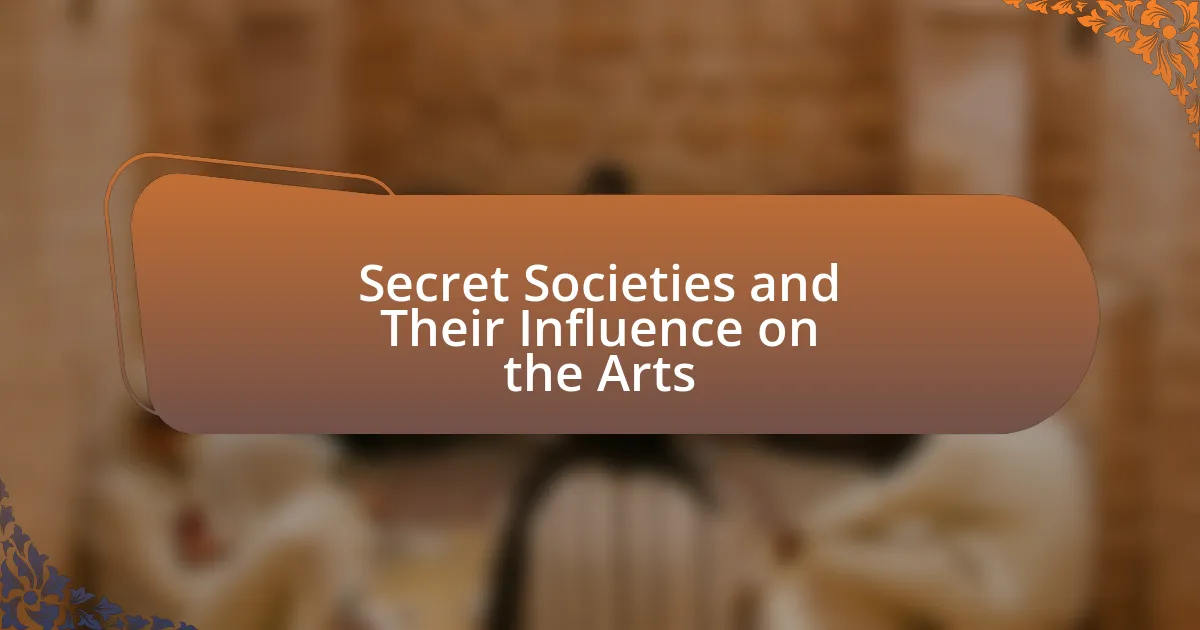Secret societies, such as the Freemasons, Rosicrucians, and Illuminati, have historically operated in secrecy, influencing cultural movements and artistic expression through their exclusive networks and ideologies. These organizations emerged during periods of social upheaval, promoting values like enlightenment and individualism, which shaped the works of notable artists and intellectuals. The article explores the historical context of these societies, their impact on the arts, the motivations for membership, and the ethical considerations surrounding their influence. Additionally, it examines how contemporary secret societies continue to affect artistic themes and styles, as well as the potential risks and benefits for artists involved with these groups.

What are Secret Societies and Their Historical Context?
Secret societies are organizations that operate in secrecy, often with exclusive membership and hidden agendas. Historically, these societies have emerged in various cultures, such as the Freemasons in the 18th century, which sought to promote Enlightenment ideals, and the Illuminati, founded in 1776, which aimed to influence political decisions and promote rationalism. Their historical context includes periods of social upheaval, where members sought to challenge established norms and exert influence over political and cultural landscapes. For instance, the Rosicrucians in the early 17th century combined mysticism with scientific inquiry, reflecting the era’s intellectual currents. These societies have often been linked to significant cultural movements, influencing art, literature, and philosophy through their clandestine networks and shared ideologies.
How have secret societies influenced cultural movements throughout history?
Secret societies have significantly influenced cultural movements throughout history by providing a framework for the exchange of ideas, fostering artistic innovation, and promoting social change. For instance, the Freemasons, established in the late 16th century, played a crucial role in the Enlightenment, encouraging values such as reason and individualism that shaped modern art and literature. Their influence is evident in the works of prominent figures like Mozart, whose compositions often reflected Masonic themes. Similarly, the Rosicrucians, emerging in the early 17th century, inspired the Romantic movement by emphasizing mysticism and the exploration of the human experience, impacting artists like William Blake. These societies often operated in secrecy, allowing members to explore radical ideas without societal constraints, thus driving cultural evolution.
What are some notable secret societies that have impacted the arts?
Notable secret societies that have impacted the arts include the Freemasons, the Rosicrucians, and the Illuminati. The Freemasons, established in the late 16th to early 17th century, have influenced various artists, including composers like Mozart and painters like Manet, through their emphasis on enlightenment and moral values. The Rosicrucians, originating in the early 17th century, promoted esoteric knowledge and inspired artists such as Salvador Dalí, who incorporated their mystical themes into his work. The Illuminati, founded in 1776, has been linked to various cultural movements and has inspired numerous works of fiction and art, reflecting themes of secrecy and enlightenment. These societies have shaped artistic expression by fostering networks of creativity and philosophical exploration.
How did the historical context shape the formation of these societies?
The historical context significantly shaped the formation of secret societies by influencing their ideologies, membership, and activities. For instance, during the Enlightenment in the 18th century, the rise of rational thought and individualism led to the establishment of societies like the Freemasons, which promoted ideas of liberty, equality, and fraternity. This period also saw a reaction against authoritarian regimes, prompting the formation of clandestine groups that sought to challenge the status quo and promote progressive ideas. Additionally, the political turmoil of the French Revolution catalyzed the growth of secret societies, as individuals sought refuge in networks that provided mutual support and shared revolutionary ideals. These contexts not only defined the purpose of these societies but also influenced their artistic expressions, as members often used art as a means to convey their messages and ideals covertly.
Why do artists and intellectuals join secret societies?
Artists and intellectuals join secret societies primarily for the pursuit of knowledge, networking opportunities, and the desire for creative freedom. These societies often provide a platform for members to exchange ideas and collaborate on artistic endeavors away from public scrutiny. Historical examples include the Rosicrucians and the Freemasons, which attracted prominent figures like Mozart and Goethe, who sought both intellectual stimulation and a sense of belonging. The secrecy surrounding these societies can also foster an environment where unconventional ideas can flourish, allowing artists and intellectuals to explore themes and concepts that may be considered taboo or controversial in mainstream society.
What motivations drive individuals to seek membership in these groups?
Individuals seek membership in secret societies primarily for social connection, personal growth, and access to exclusive knowledge or networks. These motivations stem from the desire for belonging, the pursuit of self-improvement, and the allure of participating in a community that offers unique insights or opportunities. Historical evidence shows that many members are drawn to the promise of camaraderie and support, as seen in organizations like the Freemasons, which emphasize fellowship and mutual aid among members. Additionally, the secrecy and exclusivity of these groups often enhance their appeal, creating a sense of intrigue and prestige that attracts individuals seeking to elevate their social status or influence within cultural and artistic spheres.
How do secret societies provide support for artistic endeavors?
Secret societies provide support for artistic endeavors primarily through funding, networking opportunities, and the promotion of artistic freedom. These organizations often pool resources to finance projects that align with their values or interests, enabling artists to pursue ambitious works without the constraints of commercial pressures. For instance, the Freemasons have historically supported various art forms, including architecture and music, by sponsoring artists and commissioning works that reflect their ideals. Additionally, secret societies create exclusive networks that connect artists with patrons, critics, and other creatives, fostering collaboration and innovation. This support can lead to significant cultural contributions, as seen in the Renaissance, where secretive groups played a crucial role in the patronage of artists like Michelangelo and Leonardo da Vinci.

What is the Relationship Between Secret Societies and Artistic Expression?
Secret societies often serve as platforms for artistic expression by providing a space for creative individuals to explore themes of secrecy, identity, and societal critique. Historically, organizations like the Freemasons and the Rosicrucians have influenced art through their symbolism and philosophies, which artists incorporate into their work. For example, the use of Masonic symbols in the architecture of buildings, such as the United States Capitol, illustrates how these societies have left a tangible mark on artistic expression. Additionally, many artists have been members of secret societies, allowing them to share ideas and collaborate in ways that challenge mainstream artistic norms. This relationship highlights the interplay between clandestine knowledge and public art, enriching the cultural landscape.
How do secret societies influence artistic themes and styles?
Secret societies influence artistic themes and styles by providing a framework of symbolism, esoteric knowledge, and exclusive narratives that artists often incorporate into their work. For instance, the Freemasons have historically utilized symbols like the square and compass, which appear in various artworks, reflecting ideals of morality and enlightenment. Additionally, the Rosicrucians have inspired artists with themes of mysticism and spiritual transformation, evident in the works of artists like Salvador Dalí, who integrated surrealism with esoteric concepts. The influence of these societies can be traced through art movements, where their secretive nature and philosophical underpinnings shape the thematic depth and stylistic choices of artists, creating a dialogue between the visible and the hidden in art.
What specific themes are commonly associated with secret societies in art?
Common themes associated with secret societies in art include secrecy, initiation, power dynamics, and esoteric knowledge. These themes often manifest in visual symbolism, such as the use of hidden symbols or allegorical representations that convey deeper meanings understood only by members of the society. For instance, the Freemasons frequently employed symbols like the square and compass to represent moral and ethical teachings, which are central to their beliefs. Additionally, artworks depicting secret rituals or gatherings often highlight the exclusivity and mystique surrounding these societies, reinforcing their allure and influence in cultural narratives.
How do artists incorporate symbolism from secret societies into their work?
Artists incorporate symbolism from secret societies into their work by integrating specific motifs, imagery, and themes that reflect the beliefs and values of these groups. For example, the use of the all-seeing eye, often associated with Freemasonry, appears in various artworks to convey concepts of enlightenment and hidden knowledge. Additionally, artists may employ geometric shapes and patterns, such as the pentagram or the ouroboros, which are prevalent in esoteric traditions, to evoke a sense of mystery and depth. Historical evidence shows that artists like Salvador Dalí and Man Ray drew inspiration from secret societies, using their symbols to challenge societal norms and provoke thought. This incorporation not only enriches the visual narrative but also invites viewers to explore the underlying meanings connected to these secretive organizations.
What role do secret societies play in the promotion of artists?
Secret societies often play a significant role in the promotion of artists by providing exclusive networks, financial support, and platforms for visibility. These organizations, such as the Freemasons or the Rosicrucians, historically fostered artistic talent by connecting artists with influential patrons and facilitating access to resources that might otherwise be unavailable. For example, the Freemasons have been known to support various artists through commissions and exhibitions, thereby enhancing their public profiles and career opportunities. This support can lead to increased recognition and success in the art world, as artists gain credibility and visibility through association with these prestigious groups.
How do these societies facilitate networking among artists?
Secret societies facilitate networking among artists by providing exclusive platforms for collaboration, mentorship, and resource sharing. These societies often host private events, workshops, and exhibitions that allow artists to connect with peers and industry leaders, fostering relationships that can lead to collaborative projects and career advancement. For example, the Freemasons have historically supported artists through patronage and networking opportunities, enabling members to gain visibility and access to influential circles. Additionally, societies may offer access to funding, grants, and shared spaces, further enhancing the ability of artists to network and collaborate effectively.
What impact does membership have on an artist’s career trajectory?
Membership in secret societies can significantly enhance an artist’s career trajectory by providing exclusive networking opportunities, access to resources, and increased visibility. For instance, artists who are part of influential groups often gain connections with established figures in the art world, leading to collaborations and exhibitions that might not be available to non-members. Historical examples include the involvement of artists like Pablo Picasso in the avant-garde circles of the early 20th century, which facilitated his rise to prominence. Additionally, membership can offer financial support through grants or patronage, further propelling an artist’s career. Thus, the impact of membership is multifaceted, influencing both the social and economic aspects of an artist’s professional journey.

What Are the Modern Implications of Secret Societies in the Arts?
Modern implications of secret societies in the arts include the influence on artistic expression, themes of exclusivity, and the perpetuation of certain ideologies. These societies often serve as networks for artists, providing support and resources that can shape creative output. For instance, the Freemasons have historically influenced various art movements, promoting values such as enlightenment and moral integrity, which can be seen in the works of artists like William Blake. Additionally, the secrecy surrounding these societies can lead to a mystique that enhances the appeal of certain artworks, as seen in the works of contemporary artists who reference esoteric symbols and themes. This interplay between secrecy and artistic creation continues to provoke discussions about authenticity, access, and the role of hidden knowledge in the arts.
How do contemporary secret societies operate within the art world?
Contemporary secret societies operate within the art world by influencing artistic trends, promoting specific artists, and controlling access to exclusive exhibitions and auctions. These societies often consist of influential collectors, curators, and artists who collaborate to shape the market and cultural narratives surrounding art. For instance, organizations like the Skull and Bones or the Freemasons have historically been linked to the promotion of certain artists and styles, leveraging their networks to elevate particular works or movements. This influence can be seen in the way certain artworks achieve high auction prices or gain critical acclaim, often due to the backing of these powerful groups.
What are some examples of modern secret societies influencing the arts?
Modern secret societies that influence the arts include the Freemasons, the Rosicrucians, and the Skull and Bones society. The Freemasons have historically supported artists and architects, evident in their contributions to the design of significant structures like the United States Capitol, which features Masonic symbolism. The Rosicrucians, known for their esoteric beliefs, have inspired various artistic movements, including Surrealism, as seen in the works of artists like Salvador Dalí, who incorporated mystical themes. The Skull and Bones society, associated with Yale University, has connections to influential figures in literature and film, such as George H.W. Bush and John Kerry, impacting cultural narratives through their networks. These societies demonstrate a tangible influence on artistic expression and cultural production in contemporary society.
How has technology changed the dynamics of secret societies in the arts?
Technology has significantly altered the dynamics of secret societies in the arts by enhancing communication, collaboration, and dissemination of information. Digital platforms and social media have enabled these societies to connect members more efficiently, share artistic works, and promote their agendas without traditional barriers. For instance, encrypted messaging apps allow for secure discussions, while online forums facilitate the exchange of ideas and artistic techniques among members globally. This shift has led to increased visibility and influence of secret societies in the arts, as seen in the rise of online art collectives that operate under a veil of anonymity yet reach wider audiences.
What ethical considerations arise from the influence of secret societies on art?
The ethical considerations arising from the influence of secret societies on art include issues of authenticity, censorship, and the potential for manipulation of artistic expression. Secret societies often operate in secrecy, which can lead to questions about the true intentions behind their support or promotion of certain artworks. For instance, when art is created or endorsed by these groups, it may reflect their ideologies rather than genuine artistic expression, raising concerns about the integrity of the art itself. Additionally, the influence of these societies can result in censorship, where artists may feel pressured to conform to the values or beliefs of the society, thereby limiting creative freedom. Historical examples, such as the role of the Freemasons in the commissioning of public monuments, illustrate how secretive agendas can shape public art in ways that may not align with broader societal values.
How do secret societies navigate issues of exclusivity and accessibility in the arts?
Secret societies navigate issues of exclusivity and accessibility in the arts by creating selective membership criteria that often prioritize connections and shared values among members. This exclusivity allows them to maintain a level of control over artistic expression and access to resources, which can enhance the perceived value of their artistic contributions. For instance, organizations like the Freemasons have historically supported artists and intellectuals within their ranks, fostering a network that promotes specific artistic ideologies while limiting broader public access. This dynamic can lead to a duality where the arts produced are both exclusive to members and simultaneously influential in shaping mainstream culture, as seen in the works of artists who were part of such societies, like Pablo Picasso and his connections to secretive groups.
What are the potential risks for artists involved with secret societies?
Artists involved with secret societies face several potential risks, including loss of creative autonomy, reputational damage, and legal repercussions. The influence of secret societies can lead to pressure to conform to specific ideologies or artistic directions, which may compromise an artist’s individual expression. Additionally, associations with secretive organizations can result in public backlash or negative perceptions, impacting an artist’s career and marketability. Legal risks may arise from the clandestine nature of these groups, potentially involving contracts or agreements that could lead to disputes or litigation. Historical examples, such as the controversies surrounding artists linked to groups like the Freemasons, illustrate how such affiliations can complicate public perception and professional relationships.
What practical steps can artists take to engage with secret societies responsibly?
Artists can engage with secret societies responsibly by conducting thorough research to understand the values, history, and ethical implications of the society they wish to connect with. This foundational knowledge allows artists to align their work with the society’s principles while maintaining their integrity. Additionally, artists should seek transparency in their interactions, ensuring that any collaboration or participation does not compromise their artistic vision or personal beliefs. Establishing clear boundaries and communicating openly with society members can prevent misunderstandings and ethical dilemmas. Furthermore, artists should consider the potential impact of their involvement on their audience and community, ensuring that their engagement promotes positive dialogue rather than secrecy or exclusivity.
How can artists identify reputable secret societies that align with their values?
Artists can identify reputable secret societies that align with their values by conducting thorough research on the society’s mission, history, and member testimonials. Investigating the society’s public presence, such as its website and social media, can provide insights into its activities and community engagement. Additionally, artists should seek recommendations from trusted peers or mentors who have experience with such organizations. For example, societies with a long-standing history, like the Freemasons, often have documented values and community contributions that can be verified through historical records and publications. This approach ensures that artists connect with societies that genuinely reflect their personal and professional ethics.
What strategies can artists use to leverage their membership for career growth?
Artists can leverage their membership in secret societies for career growth by utilizing networking opportunities, gaining access to exclusive resources, and enhancing their visibility within the art community. Membership in these societies often provides artists with connections to influential figures, which can lead to collaborations, exhibitions, and mentorship opportunities. For instance, artists may participate in private events or exhibitions that are only accessible to members, allowing them to showcase their work to a targeted audience. Additionally, many secret societies offer workshops, grants, or funding opportunities that can support an artist’s projects and professional development. This strategic use of membership can significantly enhance an artist’s reputation and marketability in the competitive art world.
